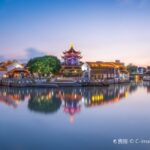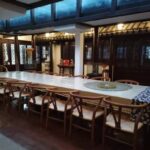Yuanjin Buddhist Temple is one of the twelve scenic spots of Qinghua Pavilion. It was built in the Zhizheng period of the Yuan Dynasty and is located by the Caogang River. There is a statue of the Virgin of Chenzhou in the temple, so it is also known as ‘Goddess Temple’. The current Yuanjin Buddhist Temple was rebuilt later. The gate is very small, but there is a unique world inside after entering. Although the temple is adjacent to the street, it is quiet, simple, and antique. The structure inside the courtyard is small and there are not many Buddha statues, but they are all exquisitely carved, dazzling, solemn and majestic. The Qinghua Pavilion at the back of the courtyard is even more famous. It is not only a place where famous scholars and literati collect calligraphy and paintings, but also has a beautiful environment. Climbing up to the top floor of the building and looking far and near, one can have a panoramic view of the beautiful scenery of Zhuxi. In history, the temple was an important cultural relic storage place. Since the Ming and Qing Dynasties, many scholars and literati have come here admiringly. The temple has become a gathering place for literati in the Ming and Qing Dynasties. Unfortunately, many precious cultural relics in the courtyard were partially destroyed in wars and some were stolen and sold by unworthy monks in the temple. By the end of the 1940s, there were not many treasures left. Later, most of them were taken over by the Cultural Relics Management Committee of Jiangsu Province and collected in museums in Jiangsu Province and Suzhou City. A few are preserved in the Qingpu County Museum. In the early 1950s, the temple was demolished. Now there are still the ‘Records of Rebuilding Qinghua Pavilion’ written by Wang Chang, the ‘Inscription on the Pagoda of Elder Zhenhua’, and the ‘Records of Rebuilding the Main Hall’ written by Shen Guangying. These stone tablets have become the only cultural relics left by the temple. Opening hours: Open from 08:30 to 16:30 all year round.
Yuanjin Buddhist Temple
Yuanjin Buddhist Temple is one of the twelve scenic spots of Qinghua Pavilion. It was built in the Z[...]









